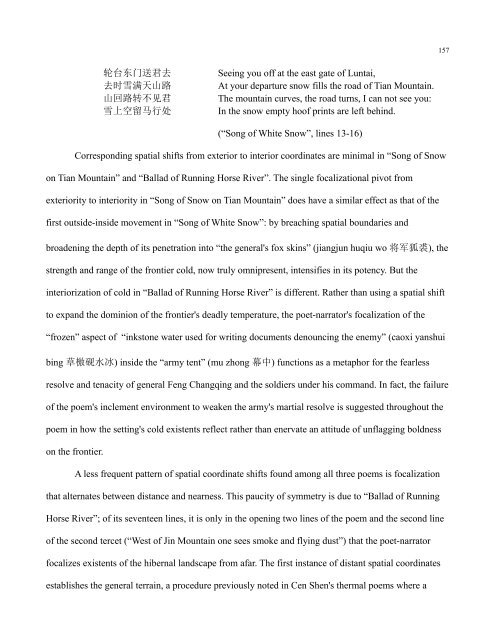View/Open - University of Victoria
View/Open - University of Victoria
View/Open - University of Victoria
You also want an ePaper? Increase the reach of your titles
YUMPU automatically turns print PDFs into web optimized ePapers that Google loves.
157<br />
轮 台 东 门 送 君 去<br />
去 时 雪 满 天 山 路<br />
山 回 路 转 不 见 君<br />
雪 上 空 留 马 行 处<br />
Seeing you <strong>of</strong>f at the east gate <strong>of</strong> Luntai,<br />
At your departure snow fills the road <strong>of</strong> Tian Mountain.<br />
The mountain curves, the road turns, I can not see you:<br />
In the snow empty ho<strong>of</strong> prints are left behind.<br />
(“Song <strong>of</strong> White Snow”, lines 13-16)<br />
Corresponding spatial shifts from exterior to interior coordinates are minimal in “Song <strong>of</strong> Snow<br />
on Tian Mountain” and “Ballad <strong>of</strong> Running Horse River”. The single focalizational pivot from<br />
exteriority to interiority in “Song <strong>of</strong> Snow on Tian Mountain” does have a similar effect as that <strong>of</strong> the<br />
first outside-inside movement in “Song <strong>of</strong> White Snow”: by breaching spatial boundaries and<br />
broadening the depth <strong>of</strong> its penetration into “the general's fox skins” (jiangjun huqiu wo 将 军 狐 裘 ), the<br />
strength and range <strong>of</strong> the frontier cold, now truly omnipresent, intensifies in its potency. But the<br />
interiorization <strong>of</strong> cold in “Ballad <strong>of</strong> Running Horse River” is different. Rather than using a spatial shift<br />
to expand the dominion <strong>of</strong> the frontier's deadly temperature, the poet-narrator's focalization <strong>of</strong> the<br />
“frozen” aspect <strong>of</strong> “inkstone water used for writing documents denouncing the enemy” (caoxi yanshui<br />
bing 草 檄 砚 水 冰 ) inside the “army tent” (mu zhong 幕 中 ) functions as a metaphor for the fearless<br />
resolve and tenacity <strong>of</strong> general Feng Changqing and the soldiers under his command. In fact, the failure<br />
<strong>of</strong> the poem's inclement environment to weaken the army's martial resolve is suggested throughout the<br />
poem in how the setting's cold existents reflect rather than enervate an attitude <strong>of</strong> unflagging boldness<br />
on the frontier.<br />
A less frequent pattern <strong>of</strong> spatial coordinate shifts found among all three poems is focalization<br />
that alternates between distance and nearness. This paucity <strong>of</strong> symmetry is due to “Ballad <strong>of</strong> Running<br />
Horse River”; <strong>of</strong> its seventeen lines, it is only in the opening two lines <strong>of</strong> the poem and the second line<br />
<strong>of</strong> the second tercet (“West <strong>of</strong> Jin Mountain one sees smoke and flying dust”) that the poet-narrator<br />
focalizes existents <strong>of</strong> the hibernal landscape from afar. The first instance <strong>of</strong> distant spatial coordinates<br />
establishes the general terrain, a procedure previously noted in Cen Shen's thermal poems where a
















